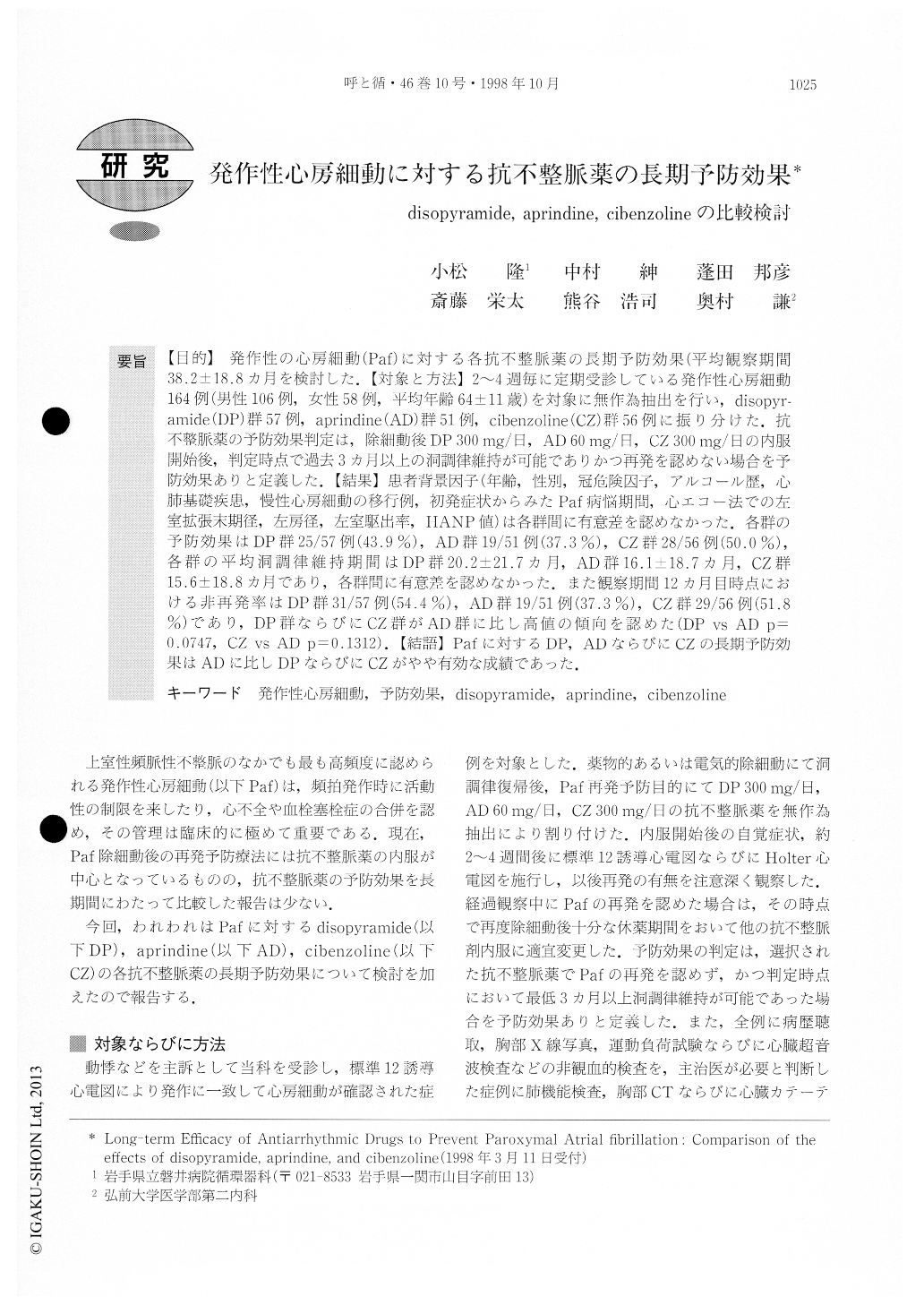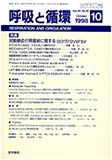Japanese
English
- 有料閲覧
- Abstract 文献概要
- 1ページ目 Look Inside
【目的】発作性の心房細動(Paf)に対する各抗不整脈薬の長期予防効果(平均観察期間38.2±18.8カ月を検討した.【対象と方法】2〜4週毎に定期受診している発作性心房細動164例(男性106例,女性58例,平均年齢64±11歳)を対象に無作為抽出を行い,disopyr—amide(DP)群57例,aprindine(AD)群51例,cibenzoline(CZ)群56例に振り分けた.抗不整脈薬の予防効果判定は,除細動後DP 300mg/日,AD 60mg/日,CZ 300mg/日の内服開始後,判定時点で過去3カ月以上の洞調律維持が可能でありかつ再発を認めない場合を予防効果ありと定義した.【結果】患者背景因子(年齢,性別,冠危険因子,アルコール歴,心肺基礎疾患,慢性心房細動の移行例,初発症状からみたPaf病悩期間,心エコー法での左室拡張末期径,左房径,左室駆出率,HANP値)は各群間に有意差を認めなかった.各群の予防効果はDP群25/57例(43.9%),AD群19/51例(37.3%),CZ群28/56例(50.0%),各群の平均洞調律維持期間はDP群20.2±21.7カ月,AD群16.1±18.7カ月,CZ群15.6±18.8カ月であり,各群間に有意差を認めなかった.また観察期間12カ月目時点における非再発率はDP群31/57例(54.4%),AD群19/51例(37.3%),CZ群29/56例(51.8%)であり,DP群ならびにCZ群がAD群に比し高値の傾向を認めた(DP vs AD p=0.0747,CZ vs Ar)p=0.1312).【結語】Pafに対するDP,ADならびにCZの長期予防効果はADに比しDPならびにCZがやや有効な成績であった.
To assess the long-term efficacy of disopyramide (DP), aprindine (AD) and cibenzoline (CZ) in patients suffering from episodes of paroxymal atrial fibrillation (Paf), 164 patients (106 men, 58 women, mean age 64±11 years) were enrolled in a randomized, prospective study(the mean follow-up 38.2±18.8 months). Of the 164 patients enrolled in this study, 57 patients received disopyramide (300mg/day. P.O). 51 patients received aprindine (60mg/day, P.O), 56 patients received ciben-zoline (300mg/day, P.O). The pharmacological efficacy of successful prevention was defined as the maintenance of sinus rhythm and event-free episodes for over 3 months at least after administration. There was no significant difference in age, sex, alcohol use, coronary risk factor, organic heart and lung disease, the duration from onset of Paf, the rate of development into perma-nent atrial fibrillation, echocardiograghic parameters and human atrial natriuretic polypeptide between the groups. The successful rates of pharmacological preven-tion were 43.9% in the DP-treated group, 37.3% in the AD-treated group. 50.0% in the CZ-treated group. respectively (p= NS). The mean periods for mainte-nance of sinus rhythm were 20.2 ± 21.7 months in the DP -treated group, 16.1±18.7 month in the AD-treated group, 15.6±18.8 months in the CZ-treated group. respectively (P=NS). The proportion of patients remain-ing in sinus rhythm on each agent was calculated for each group by the Kaplan-Meier method. Actual event -free rates were 82.4%, 70.2% and 54.4% in the DP-treated group. 82.4%, 60.8% and 37.3% in the AD-treat-ed group, 91.7%, 57.1% and 51.8% in the CZ treated group at 1, 6 and 12 months, respectively (DP vs AD p= 0.0747. CZ vs AD p=0.1312 at 12 months). In conculsion, DP and CZ have a more fesible long-term efficacy for maintaining normal sinus rhythm in patients with par-oxymal atrial fibrillation than AD.

Copyright © 1998, Igaku-Shoin Ltd. All rights reserved.


